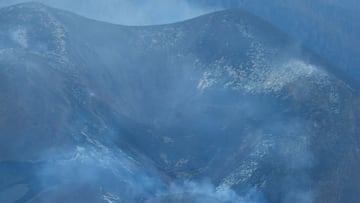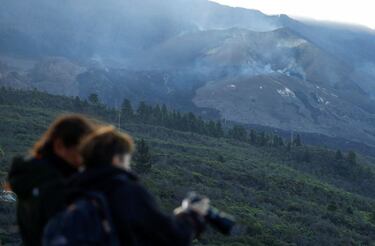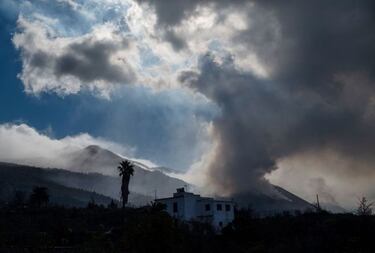La Palma volcano: experts say Cumbre Vieja eruption may be over
The National Geographic Institute says the Cumbre Vieja eruption appears to be over: "There is no lava emission and no sign of seismic activity."

The Cumbre Vieja eruption on La Palma, which has been ongoing for almost three months and has caused the evacuation of thousands of residents, the destruction of almost 3,000 buildings and an estimated €1 billion in damages, appears to over according to experts. It has now been more than 24 hours since any indication that the volcano is still active was registered, with volcanologists in agreement that a period of 48 hours with no indications of continued activity can be regarded as confirmation that the eruption has ceased. “There is no lava emission, no sulfur dioxide, and no sign of any tremors or seismicity,” sources from the Spanish National Geographic Institute told EL PAÍS on Tuesday.
However, given previous lulls in activity on Cumbre Vieja, the Canary Islands Volcanic Emergency Plan (Pevolca) is erring on the side of caution and will wait for a few days to announce a definitive end to the eruption.
"It's too early to tell if we're entering a terminal phase"

Around a week after the eruption started, seismic activity suddenly dropped off for several hours before restarting with renewed vigour, a pattern that is not uncommon in the early stages of an eruption, according to Stavros Meletlidis, a volcanologist with the National Geographic Institute.
But after nearly three months of activity, the eruption is in a different phase and could be losing strength.
"The magma needs energy to get to the surface and it seems that it does not have it at the moment," Meletlidis said, explaining that could be due to a decline in levels of gases or magma volume as the eruption loses force.
However, it could be the result of a blockage between subterranean magma chambers and the surface vent, in which case pressure would continue to build up until reaching critical mass and causing new explosions. "It's too early to tell if we're entering a terminal phase," Meletlidis added.
Local authorities on La Palma stated on Tuesday that the volcanic emergency “is clearly attenuated,” given that the crater is no longer emitting lava and there have been no earthquakes registered on the island since Monday evening. Seismicity is also vastly reduced, which has led experts to offer cautious optimism that the end may be in sight for residents of the canary Island, some 7,000 of whom have been displaced by the eruption.
“We cannot categorically state that we are witnessing what you want and what I want more than you: that this is over,” said Pevolca spokesman Miguel Ángel Morcuende in response to media inquiries.
Pevolca urges “caution, calm and patience”
Vídeo desde el embalse Dos Pinos a las 11.15 hora canaria / Video from the Dos Pinos dam at 11.15 Canarian time pic.twitter.com/3wP5yw8Q9E
— INVOLCAN (@involcan) December 15, 2021
Part of the reason for Pevolca’s hesitancy to announce an end to the emergency is that on Monday the volcano appeared to have ceased activity, only for a “significant explosive phase” to occur between 17:45 and 19:00 local time. As such, Morcuende warned that the renewed period of calm “gives one impression while the reality could be very different.” Pevolca’s scientific committee is therefore prescribing “caution, calm and patience.”
“In principle the situation is going reasonably well, but nothing more,” Morcuende added.
Cumbre Vieja tremors decreasing
The latest data compiled on Cumbre Vieja shows that the volcanic tremors have ceased to the extent of reaching background noise levels, which allows more intermediate earthquakes of lower intensity to be located. Now there is more seismicity in the intermediate range – between 1.1 and 3.2 magnitude – although at 10:15 local time on Wednesday a 3.5-magnitude tremor was registered.
Related stories
However, despite an increase in earthquake detection, seismicity at intermediate depths remains low and the number of earthquakes at depths greater than 20 kilometers remains very low.
Air quality improving on La Palma

Air quality on the island has also been improving, after dangerous levels of sulfur dioxide emissions forced the local government to issue stay-at-home orders for residents of Los Llanos de Aridane, El Paso and Tazacorte earlier this week. In the former air quality is now considered to be acceptable while in the latter two neighborhoods it is good to very good.
- Volcanic eruption La Palma
- La Palma
- Volcanic eruptions
- Provincia Santa Cruz de Tenerife
- Earthquakes
- Emergency evacuation
- Science
- Spanish government
- Volcanes
- Geology
- Canarias
- Earthquake
- Natural spaces
- Natural disasters
- Emergencies
- Disasters
- Government
- Accidents and crimes
- State administration
- Spain
- Environment
- Public administration
- Politics
- Life sciences

